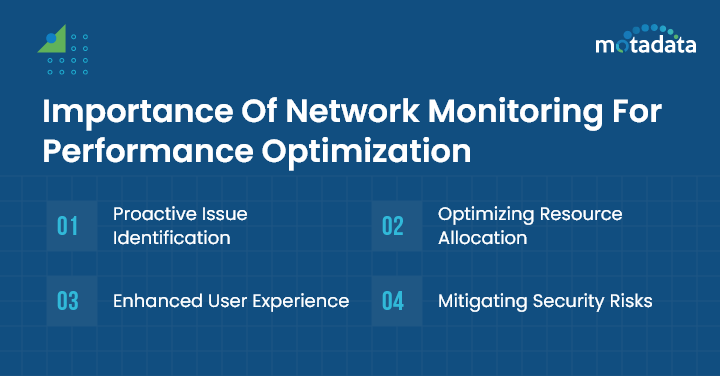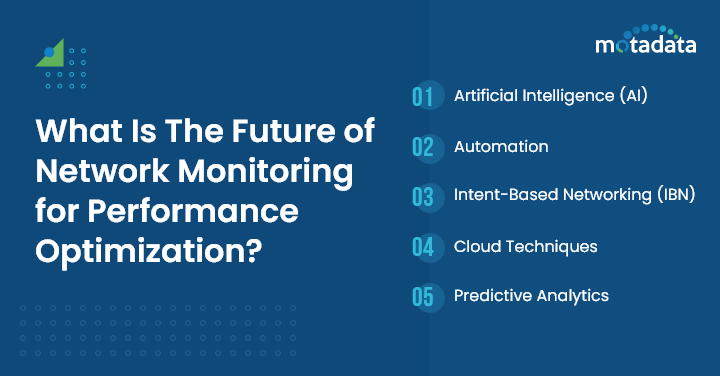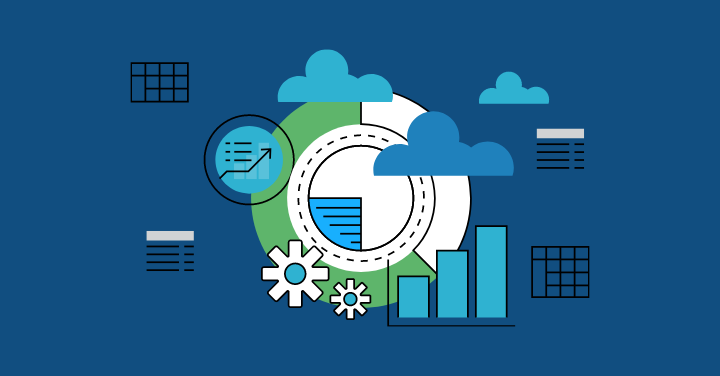In today’s interconnected world, network performance and network management is critical for businesses to function seamlessly.
Whether it’s ensuring smooth communication, efficient data transfer, or secure transactions, a well-monitored network is essential.
This article delves into the importance of network monitoring in maintaining optimal performance.
It explores the challenges faced by network administrators in managing complex networks, defines network performance optimization and its goals, and discusses critical aspects for the quality of service such as bandwidth utilization, load balancing, latency, jitter, packet loss, and error rates.
Additionally, the role of such network monitoring tools in achieving optimization and essential metrics for measuring network performance are highlighted.
Best practices for network optimization, including implementing NPM tools, configuration management, timely alert escalation frameworks, automated solutions for network problems, and minimizing downtime.
As network resources become more complex, staying updated on the latest advancements and trends is crucial.
Let’s delve into how businesses can achieve reliable network monitoring and optimize their performance.
What Is Network Monitoring And Network Monitoring Performance?
Network monitoring allows organizations to proactively identify issues, prevent downtime, and enhance overall efficiency.
Network monitoring is a continual process, and the primary objective of network monitoring is to ensure optimal network operation, identify and troubleshoot network faults or performance bottlenecks in real-time, prevent potential disruptions to network services, and gain insights into network usage patterns, identify potential security threats; maintaining the stability, reliability, and security of computer networks, thereby supporting the efficient operation of businesses and organizations.
Let’s look at some of the critical aspects of network monitoring for performance optimization where we talk about things like network speed, network hardware, network throughput and maximizing network performance.
What Is Network Performance Optimization?
Network performance optimization is the process of maximizing network performance by improving the speed, reliability, and efficiency of a network by applying various techniques and tools.
It aims to achieve the best possible user experience and business outcomes by ensuring optimal network performance and availability avoiding any further network issues.
This procedure includes several methods designed to enhance the network infrastructure’s general functionality, speed, and responsiveness.
Amongst the crucial elements of comprehending network performance optimization are:
Measuring Performance Metrics
To find areas for improvement, this entails examining network performance measures, including packet loss, access points, network design, throughput, latency, and other security measures.
Bandwidth Management
Bandwidth management is the effective use and distribution of network capacity to provide priority to essential services which improves the overall application performance.
Protocol Optimization
Protocol optimization is the process of continuous monitoring and streamlining network protocols to reduce overhead and boost the effectiveness of data transfer.
Network Troubleshooting
Finding and fixing problems with the network quickly to keep it operating at peak efficiency.
Organizations can enhance the user experience by improving network performance, bandwidth usage, reliability, and scalability by comprehending these strategies.
Importance Of Network Monitoring For Performance Optimization
Making sure that the network is performing at its best is essential in the modern digital world.
Network monitoring is fundamental in proactively detecting and resolving problems that affect user experience and overall performance.
Effective monitoring is not just about keeping an eye on the current state of the network; it’s about anticipating issues before they escalate and strategically planning for future growth and demands for critical applications.
Let’s explore more about the importance of an optimized network and most importantly, its monitoring or tools that help in maximizing network performance.
1. Proactive Issue Identification
Network monitoring and other such management tools enables companies and data centers to identify any problems like network congestions with traffic analysis parameters early on and take action before they get out of hand.
IT teams can quickly detect security risks, performance bottlenecks, and other problems by continually monitoring components, including servers, routers, switches, and any other wireless network or apps.
2. Optimizing Resource Allocation
Using network surveillance for traffic shaping, establishments can acquire discernment into the patterns of network traffic and resource usage to track potential issues.
With the use of this data, capacity planning and resource allocation decisions can be made with knowledge, guaranteeing both cost-effectiveness and peak performance.
3. Enhanced User Experience
Organisations may guarantee a flawless user experience by proactively tracking performance parameters for efficient network, network availability, including latency, packet loss, and bandwidth utilization.
User happiness increases when performance issues are quickly identified and fixed to reduce latency, downtime, and service interruptions.
4. Mitigating Security Risks
Reducing security risks, including malware, DDoS assaults, and unauthorized access attempts, is mainly dependent on the monitoring.
Implementing a DDoS protection solution can further enhance your defenses by detecting and mitigating potential threats before they disrupt operations.
Organizations can identify security breaches early on and put the appropriate safeguards in place to protect their networks by keeping an eye on network traffic and unusual behavior patterns.
To sum up, network monitoring is critical to maximizing network performance and the efficacy of digital infrastructures by assuring dependability, flow of data, data transmission, improving security, and optimizing performance that helps in cost savings.
Strategies For Maximizing Network Performance Monitoring And Optimization
Monitoring and optimization are two essential processes for ensuring the performance and reliability of applications and systems.
Monitoring historical data of network entails gathering and examining data on a range of performance metrics, including throughput, error rate, response time, and resource usage.
Strategies for effective monitoring and optimization involve a systematic approach for these network configurations to overseeing and improving various processes, systems, or resources to achieve desired outcomes efficiently.
Some of the strategies for effective monitoring and optimization are:
Define clear and measurable performance goals and metrics.
This helps to align the monitoring and optimization efforts with the business objectives and user expectations.
Employ a blend of simulated and actual user monitoring instruments to gather information from various angles and sites.
Synthetic monitoring simulates user interactions and tests the availability and functionality of applications and systems.
Accurate user monitoring collects data from actual users and provides insights into user behavior and satisfaction.
Examine the information gathered by the monitoring tools to find areas of poor performance, bottlenecks, and room for enhancement.
Use tools that provide visualizations, dashboards, and alerts to facilitate the analysis and communication of performance data.
Implement optimization techniques and tools to enhance the performance and efficiency of applications and systems.
Use tools that provide recommendations, automation, and feedback loops to facilitate the optimization process.
Continuously monitor and optimize the performance of applications and systems. Performance is a continuous process that needs to be continuously assessed and improved. It is not a one-time event.
What Is The Future Of Network Monitoring For Performance Optimization?
In the future, for modern networks, the integration of Big Data analytics, AI, ML, and real-time monitoring will play a crucial role in network monitoring for future networks which will eventually have a better performance.
These technologies empower enterprises to identify abnormalities, proactively manage network performance, and enhance user experience, especially analysing a bigger threat like intrusion detection which gives big companies a competitive advantage over the other ones.
Let’s explore the key factors that will shape the future of network monitoring:
Artificial Intelligence (AI)
AI-powered algorithms will play a significant role in analyzing vast amounts of network data in real time, identifying patterns, anomalies, and trends that human operators might miss.
Automation
Automation will streamline network monitoring processes, enabling faster responses to issues and more efficient resource allocation.
Intent-Based Networking (IBN)
IBN will enable networks to align with business objectives automatically, optimizing performance based on predefined intents and policies.
Cloud Techniques
As cloud services become more widely used, services network monitoring tools will need to adapt to monitor and optimize performance across hybrid and multi-cloud environments.
Predictive Analytics
Predictive analytics will also play a crucial part in network monitoring systems. It will enable pre-emptive actions to prevent downtime and will also support enhancing performance.
These advancements signify a future where network monitoring evolves to be more proactive, intelligent, and adaptable, leading to enhanced performance optimization and a more reliable digital infrastructure.
Final Words
Maximizing network performance and security metrics requires a multifaceted approach encompassing effective monitoring and optimization strategies to rid any security vulnerabilities.
By implementing robust network performance monitoring tools and practices, businesses can proactively detect and address issues, ensuring optimal performance and reliability.
Additionally, by employing optimization techniques such as network bandwidth management, proactive capacity planning, and leveraging emerging technologies like AI and predictive analytics, organizations can further enhance their network efficiency and responsiveness.
In conclusion, by integrating comprehensive monitoring with strategic optimization efforts, businesses can achieve peak network performance, minimize downtime, and deliver seamless user experiences, thereby gaining a competitive edge in today’s digital landscape.
Remember, reliable network monitoring isn’t just about tools; it’s a strategic approach that ensures your network remains robust, secure, and ready for the challenges of tomorrow.
FAQs:
NPM involves tracking and analyzing the performance of network infrastructure to ensure optimal operation, availability, and reliability.
Strategies include setting performance baselines, using real-time monitoring tools, automating alerts, and implementing proactive maintenance.
Monitoring tools generate real-time alerts that allow IT teams to quickly address and resolve issues before they impact end users.









